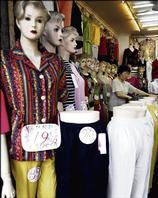
Textile products are on display in a shop in Shanghai last Wednesday. The United States and China have made "good progress" toward a potential trade deal that could curb billions of dollars in clothing imports from China, but differences remain, U.S. negotiators said last week. - REUTERS
HONG KONG (Reuters):
HONG KONG is booming as a quota-free garment re-export gateway that bypasses Chinese textile quotas as Beijing haggles over clothing trade with the European Union (EU) and the United States.
Garment makers based in Hong Kong but with plants in China are using "outward processing arrangements" (OPA) that allow manufacturers to claim their goods are made in the Special Administrative Region of Hong Kong, provided some work on the goods takes place there.
"Suddenly production in Hong Kong has surged. Suddenly Hong Kong is becoming an exporting country again," said Wing Hin Chung, director of garment manufacturer Hansa Trading Ltd.
Hong Kong's textile and clothing re-exports to the European Union and the United States rose 80 per cent and 33 per cent respectively, from April through July, according to the Hong Kong Trade and Industry Department (TID).
RE-EXPORTS
Combined re-exports to the two markets totalled HK$57.2 billion (US$7.3 billion) in the second quarter of 2005, up 49 per cent from a year earlier and matching total mainland Chinese textiles exports to the United States in the first half of 2005.
"The figures may suggest ... that Hong Kong is moving towards servicing the textile and clothing trade in the region," Trade and Industry Department (TID) spokeswoman Connie Man said.
OPA status for exported goods requires that their "principal manufacturing processes" be conducted in Hong Kong, a TID document says. Some industrialists question whether all OPA garments are what they claim to be.
"Where is it being produced? Where are all the workers coming from? Where are all the factories coming from?" one small manufacturer said.
Chinese shipments to the United States and the EU surged when a global quota system ended on January 1 this year.
Both the U.S. and the EU sought relief under World Trade Organisation rules in a bid to protect their domestic industries in what became known as the bra wars and they reintroduced restrictions on Chinese textile imports.
The EU, after impounding tens of millions of shirts, pants, bras and other items when new quotas rapidly filled up, reached a compromise deal in September that freed up those products but included lower Chinese quotas for 2006. The United States and China are still negotiating. Restrictions are expected to end altogether in 2008.
MADE IN HONG KONG
In the meantime, 'Made in Hong Kong' is back in business as Hong Kong-based companies scramble to boost their home base operations, going against the trend of the last few decades where a once-thriving industry shifted wholesale to the mainland.
In its heyday in the mid-1970s, Hong Kong's textile industry employed around half of the manufacturing workforce, or around 350,000 workers, compared to only 41,000 in March, the TID said.
But expansion and trans-shipment costs, along with restrictions on hiring workers from mainland China, have made production more expensive, and uncertainty for the industry is likely to continue, said Ruby Zhu Dan, China economist at the Hong Kong General Chamber of Commerce.
"Until 2008, companies can't do any long-term planning. And even then I think the problem's still going to be there."











